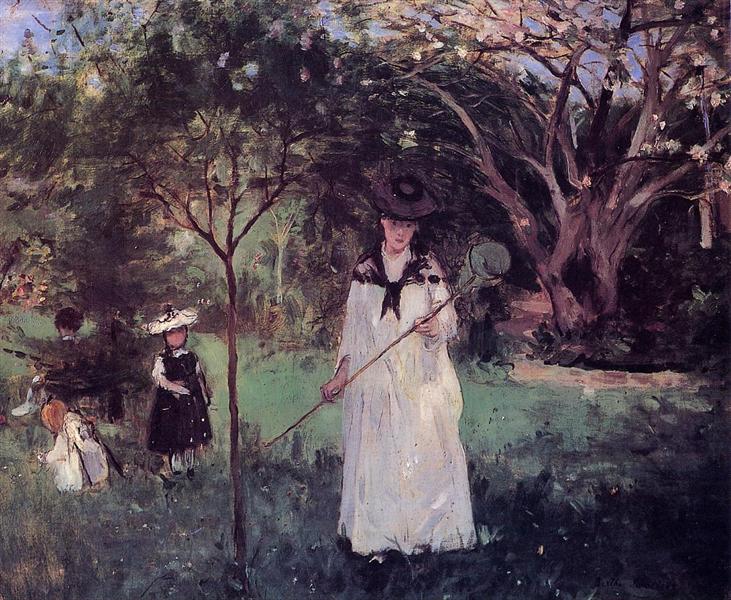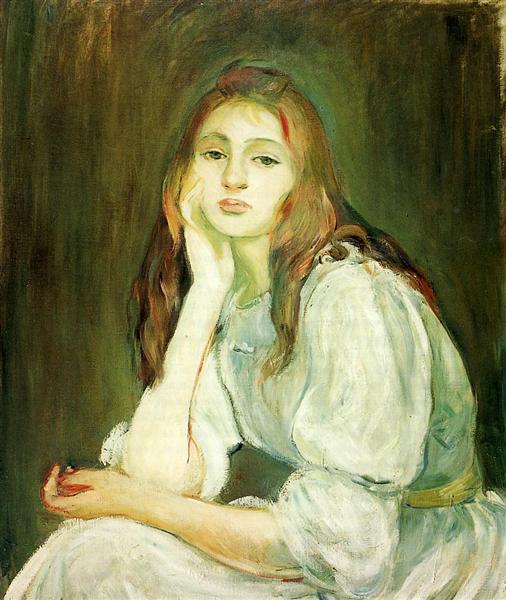For a long term it felt like Berthe Morisot (1841-1895) was The Woman Artist. In the early 1970s, when New Art History was gaining ground her role as an Impressionist, but one who also represented the social restrictions of nineteenth century women was much written about. The ubiquitous popularity of Impressionism has receded, and the boom area for feminist art history now is arguably the Baroque, with Artemisia Gentileschi leading the way, closely followed by artists like Lavinia Fontana. Morisot seems marooned in a backwater, neither a big enough name, nor enough of a novelty to garner interest. Her resolutely female domestic subject matter nowadays seems tame, almost like a flag of surrender in comparison with those seventeenth century women who so obviously colonised male artists' territory. An upcoming exhibition at Dulwich Picture Gallery (starting 31 March 2023), whilst a welcome and long overdue examination of Morisot's work, is positioning her in the context of eighteenth-century French painting and thus seems at risk of reinforcing ideas of a feminine aesthetic in her work.
Morisot, as she is presented nowadays, had it pretty easy. She came from a wealthy enough background to indulge her enthusiasm for painting with private tutors and chaperoned visits to the Louvre. She chose a husband who allowed her to continue to paint, in comparison with her sister who gave up her art to become the wife and mother society expected. Morisot's husband, Edouard Manet's brother, Eugene, is often presented as a shadowy figure persuaded into a marriage of convenience which allowed the two artists to remain close. She had only one child and so never became overwhelmed with domestic duties in the way other would-be women artists of the time were. She could afford to produce uncommercial work, and at her death over 80% of her paintings remained in the family's possession. We like our artists to struggle and somehow all these advantages seem to be held against her and her images of seemingly contented domesticity and bourgeois virtue.
The irony is that Morisot, in terms of her drive and activity within the Impressionist circle, was nothing like the little bourgeois woman sitting at home which her paintings seem determined to portray. She withstood considerable family pressure to give up her painting, finally agreeing to marry at the age of thirty-two, long after she was considered an old maid. She made a conscious decision to exhibit in what would become known at the first Impressionist exhibition in 1874, despite having previous Salon success and against the advice of Manet: she was savvy enough to see the benefits of a show which enabled her to show nine varied canvases in a less crowded and competitive environment. She similarly auctioned her work at the 1875 Hotel Drouet sale, achieving the highest price of the day. At the second Impressionist exhibition she showed more works than anyone else, and she participated in all but one of the rest, missing only the one after the birth of her daughter. Her final letter expressed hope for a future museum dedicated to Impressionism. It is a damning testament to the continued sexism of the art world, that Morisot, so deeply embedded into the Paris Impressionist circle, is not only still treated as an also-ran, but that this second-class status goes largely unchallenged.
The Impressionist movement was frequently described as feminine by contemporary critics. The unfinished nature of the work, the emphasis on transience and changeability, the importance of colour were all seen as womanly. Morisot herself was criticised for not having the masculine stamina to finish her canvases. Today we might not recognise such gendered criticism, but the perceived prettiness of much Impressionist art and brushwork which might be described as feathery, light or even fluffy continues that feminine discourse. Yet in terms of technique, Morisot is resolutely a-feminine, anti-pretty: she frequently applied paint in rapid, dashed strokes creating a sense of hurriedness, certainly, but also suggesting vigour, dynamism, sometimes even annoyance. Her colour is less pastel prettiness than cool and clear, influenced by her time as a pupil of Corot but also following a range exploited by other French naturalists of the time. Like Manet, she retained a fondness for black using it sparingly but effectively for emphasis. Her work shows such a steady development away from 'finish' that in canvases like Woman and Child in a Meadow at Bougival the figures dissolve into a semi-abstract storm of brushmarks. Only in the last years of her life did her palette warm, her interest in line return and her brushwork soften, to create works with an affinity to Auguste Renoir. Her portrait of her daughter, Julie Daydreaming, is reminiscent of Edvard Munch in its sinuous line, plain background and colour blocks creating an enigmatic mood: symbolic white, loose hair and the hint of something red in the teenager's hand.
Morisot's subject matter, with its focus on the routine and restriction of bourgeois domesticity, is often taken as another marker of femininity. Yet, whereas her contemporary, Mary Cassatt, seems consciously determined to catalogue women's lives, becoming a female 'painter of modern life', Morisot seems almost oblivious to her subjects, their faces erased, the bodies lost in the haze of brushwork. Cassatt painted female subjects at the theatre, captured as if by accident in the public gaze; Morisot's At the Ball features a dressed up, posed woman apparently sitting at home. She painted what was to hand for her own convenience, thereby avoiding the difficulties and awkwardness she described when trying to paint plein air in public. And although her closeness to those subjects - her sister, her husband, her daughter - shows through, the emotion is almost accidental. There are psychological readings of entrapment and erasure; some have focused on her supposed empathy for servants; another argument suggests that she was deliberately choosing her battles - innocuous subjects to balance her radical technical choices. All this slightly missing the point. What she is really interested in is the act of painting itself, the transmission of transience onto canvas.
Berthe Morisot is a classic example of the institutional sexism which still haunts the art world. Her subjects are seen as evidence of the restrictions under which she lived her life, as a middle class woman in the late nineteenth century, and by implication her art is belittled by those restrictions. Her gender means that she is seen as a woman first and an artist second, so subject matter and biography always seem to take precedent over the technique, and her truly radical use of paint is never fully explored. Appreciated and applauded at the time, interest in her work very quickly dwindled after her death. Surely it's time to move beyond Morisot the 'woman Impressionist' (to quote the title of the 2018 Barnes Foundation exhibition) and see her as an integral and innovative member of the movement.





No comments:
Post a Comment